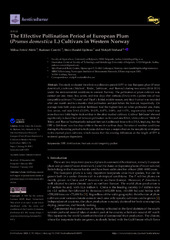The Effective Pollination Period of European Plum (Prunus domestica L.) Cultivars in Western Norway
Апстракт
This study evaluated the effective pollination period (EPP) in four European plum (Prunus domestica L.) cultivars ('Mallard', 'Edda', 'Jubileum', and 'Reeves') during two years (2018-2019) under the environmental conditions in western Norway. The pollination of plum cultivars was carried out one, three, five, seven, and nine days after anthesis (DAA) with a pollen mix of two compatible cultivars ('Victoria' and 'Opal'). Initial, middle-season, and final fruit set was recorded after one month and two months after pollination and just before the harvest, respectively. On average from both years cultivar 'Jubileum' had the highest fruit set when pollinated one, three, five, seven, and nine DAA (33.23%, 30.83%, 8.47%, 3.08%, and 1.15%, respectively), which was more than two folds higher fruit set than in the other studied cultivars. Cultivar 'Jubileum' showed significantly reduced fruit set between pollination on five and nine DAA, while cultivars 'Mallard', 'Edda', and 'Reeves' had marked...ly reduced fruit set if pollinated three to five DAA, implying that the EPP in 'Jubileum' was five days while in the rest it was three days. Variation of weather conditions during the flowering period in both years did not have a major effect on the receptivity of stigmas in the studied plum cultivars, which means that the existing differences in the length of EPP is maternal-genotype dependent.
Кључне речи:
EPP / fertilization / fruit set / ovule longevity / pollenИзвор:
Horticulturae, 2022, 8, 1, 55-Издавач:
- MDPI
DOI: 10.3390/horticulturae8010055
ISSN: 2311-7524
WoS: 000747251600001
Scopus: 2-s2.0-85122822001
Институција/група
Inovacioni centar
TY - JOUR
AU - Fotirić-Aksić, Milica
AU - Cerović, Radosav
AU - Hjeltnes, Stein Harald
AU - Meland, Mekjell
PY - 2022
UR - http://TechnoRep.tmf.bg.ac.rs/handle/123456789/5024
AB - This study evaluated the effective pollination period (EPP) in four European plum (Prunus domestica L.) cultivars ('Mallard', 'Edda', 'Jubileum', and 'Reeves') during two years (2018-2019) under the environmental conditions in western Norway. The pollination of plum cultivars was carried out one, three, five, seven, and nine days after anthesis (DAA) with a pollen mix of two compatible cultivars ('Victoria' and 'Opal'). Initial, middle-season, and final fruit set was recorded after one month and two months after pollination and just before the harvest, respectively. On average from both years cultivar 'Jubileum' had the highest fruit set when pollinated one, three, five, seven, and nine DAA (33.23%, 30.83%, 8.47%, 3.08%, and 1.15%, respectively), which was more than two folds higher fruit set than in the other studied cultivars. Cultivar 'Jubileum' showed significantly reduced fruit set between pollination on five and nine DAA, while cultivars 'Mallard', 'Edda', and 'Reeves' had markedly reduced fruit set if pollinated three to five DAA, implying that the EPP in 'Jubileum' was five days while in the rest it was three days. Variation of weather conditions during the flowering period in both years did not have a major effect on the receptivity of stigmas in the studied plum cultivars, which means that the existing differences in the length of EPP is maternal-genotype dependent.
PB - MDPI
T2 - Horticulturae
T1 - The Effective Pollination Period of European Plum (Prunus domestica L.) Cultivars in Western Norway
IS - 1
SP - 55
VL - 8
DO - 10.3390/horticulturae8010055
ER -
@article{
author = "Fotirić-Aksić, Milica and Cerović, Radosav and Hjeltnes, Stein Harald and Meland, Mekjell",
year = "2022",
abstract = "This study evaluated the effective pollination period (EPP) in four European plum (Prunus domestica L.) cultivars ('Mallard', 'Edda', 'Jubileum', and 'Reeves') during two years (2018-2019) under the environmental conditions in western Norway. The pollination of plum cultivars was carried out one, three, five, seven, and nine days after anthesis (DAA) with a pollen mix of two compatible cultivars ('Victoria' and 'Opal'). Initial, middle-season, and final fruit set was recorded after one month and two months after pollination and just before the harvest, respectively. On average from both years cultivar 'Jubileum' had the highest fruit set when pollinated one, three, five, seven, and nine DAA (33.23%, 30.83%, 8.47%, 3.08%, and 1.15%, respectively), which was more than two folds higher fruit set than in the other studied cultivars. Cultivar 'Jubileum' showed significantly reduced fruit set between pollination on five and nine DAA, while cultivars 'Mallard', 'Edda', and 'Reeves' had markedly reduced fruit set if pollinated three to five DAA, implying that the EPP in 'Jubileum' was five days while in the rest it was three days. Variation of weather conditions during the flowering period in both years did not have a major effect on the receptivity of stigmas in the studied plum cultivars, which means that the existing differences in the length of EPP is maternal-genotype dependent.",
publisher = "MDPI",
journal = "Horticulturae",
title = "The Effective Pollination Period of European Plum (Prunus domestica L.) Cultivars in Western Norway",
number = "1",
pages = "55",
volume = "8",
doi = "10.3390/horticulturae8010055"
}
Fotirić-Aksić, M., Cerović, R., Hjeltnes, S. H.,& Meland, M.. (2022). The Effective Pollination Period of European Plum (Prunus domestica L.) Cultivars in Western Norway. in Horticulturae MDPI., 8(1), 55. https://doi.org/10.3390/horticulturae8010055
Fotirić-Aksić M, Cerović R, Hjeltnes SH, Meland M. The Effective Pollination Period of European Plum (Prunus domestica L.) Cultivars in Western Norway. in Horticulturae. 2022;8(1):55. doi:10.3390/horticulturae8010055 .
Fotirić-Aksić, Milica, Cerović, Radosav, Hjeltnes, Stein Harald, Meland, Mekjell, "The Effective Pollination Period of European Plum (Prunus domestica L.) Cultivars in Western Norway" in Horticulturae, 8, no. 1 (2022):55, https://doi.org/10.3390/horticulturae8010055 . .



